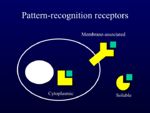Recognition of Microorganisms
The innate immune system recognises components of pathogens which are intrinsically foreign (i.e. not present on normal mammalian cells), such as:
- Lipopolysaccharides of gram-negative bacteria
- Peptidoglycans of gram-positive bacteria
- Mannose sugars
- D-isoform amino acids (abundant in Peptidoglycans) - almost all (>99%) amino acids in multicellular organisms are the L-isoform of amino acids as it is only the L-isoform amino acids that are used for protein synthesis.
These are known to the body as foreign as they are expressed as pathogen-associated molecular patterns (PAMPs) which are recognised by pattern recognition receptors (PRRs) expressed on mammalian cells. These receptors are expressed on many different cell types, not just on phagocytes, though not all are expressed by all cells: different cell types express a different range of PRRs. PRRs are either intracellular, membrane-associated or soluble:
- Recognition of pathogens via the cellular PRRs results in phagocytosis and inflammation
- Recognition of pathogens via the humoral PRRs results in various killing mechanisms
Actions
The engagement of PRRs by PAMPs triggers:
- Phagocytosis
- The expression of cytokines, which brings about inflammation and other immune responses
Pattern Recognition Receptors
| Receptor | Location | Ligands |
|---|---|---|
| TLR2 (Toll-like receptor) | Cell Membrane | Peptidoglycan of gram +ve bacteria |
| TLR3 | Cell Membrane (in Endosome) | dsRNA of RNA viruses (e.g. avian influenza) |
| TLR4 | Cell Membrane | Lipoplysaccharide from gram-negative bacteria (e.g. E. coli, Salmonella) |
| TLR5 | Cell Membrane | Bacterial flagellin |
| TLR9 | Cell Membrane (in Endosome) | Bacterial DNA (CpG DNA) |
| C-type lectins | Soluble | Carbohydrates, all bacteria, dead cells |
| fMLP | Soluble | Formyl peptides (i.e. all bacteria) |
| Complement receptors | Soluble | Fixed complement components (e.g. iC3b) |
| NOD2 | Cytoplasm | Peptidoglycan of gram +ve bacteria |
| dsRNA-dependent Protein Kinase Receptor | Cytoplasm | ds RNA of RNA viruses |
For more information on Toll-like receptors see this review [1]
References
- ↑ Lee, C.C., Avalos, A.M. and Ploegh, H.L. (2012) Accessory molecules for Toll-like receptors and their function. Nature Reviews Immunology 12: pp.168-179.
| This article has been expert reviewed by Dr Robert J Francis BSc(Hons) PhD Date reviewed: May 10, 2012 |
| Originally funded by the RVC Jim Bee Award 2007 |
